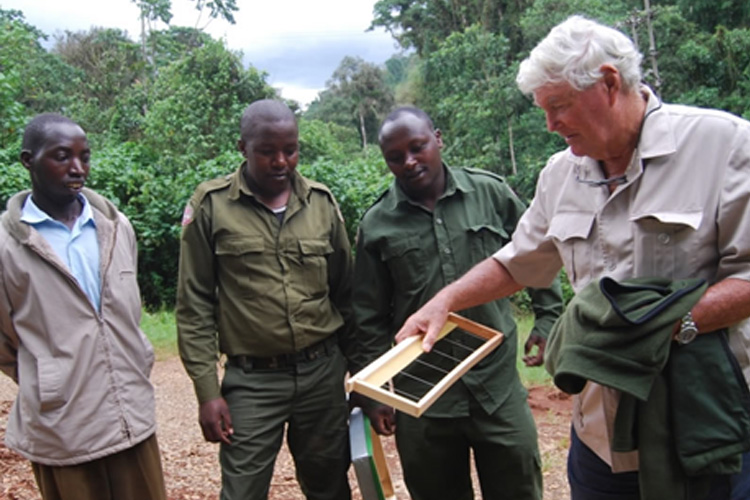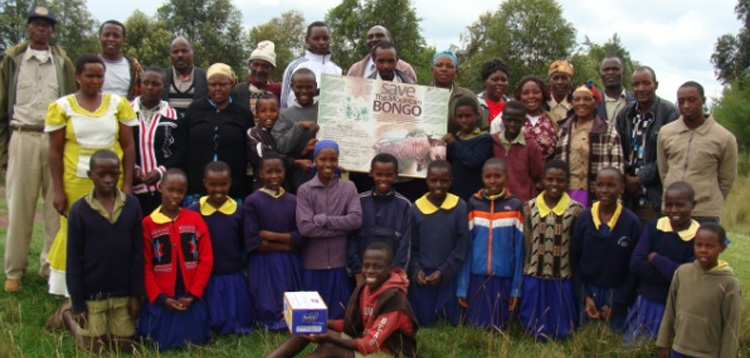Mike Prettejohn
Founder of The Bongo Surveillance Project
Mike Prettejohn and the Bongo Surveillance Project, Kenya
The Bongo Surveillance Project was founded in 2004 in the Aberdare forests of central Kenya, one of the last places the critically endangered eastern bongos are known to survive in the wild. Led by founder Mike Prettejohn, a team of experienced trackers gather scientific data on the presence and distribution of the remaining mountain bongo as well as data on human activity within the indigenous forests where these animals are found. There are possibly less than 140 Eastern or Mountain Bongo left in all of Kenya.
Michael Prettejohn was born in Kenya in 1932 and was involved in cattle ranching and later became a professional hunter. For the past 15 years, Mike has led a team of experienced trackers in gathering scientific data on the presence and distribution of the remaining mountain bongo, first in the Aberdares and then later on Mount Kenya, before moving further afield to confirm the species’ continued perilous existence in Eburu and the Mau Forests. He and his team have discovered previously-unknown populations and have championed the continued survival of this species in the wild in Kenya.
It is no exaggeration to say that this small group of committed Kenyans (and their supporters such as the Kenya Wildlife Service and the Kenya Forestry Service) can consider themselves responsible for bringing the plight of the mountain bongo into the public consciousness.MONITORING AND SURVEILLANCE PROGRAMME
The objective of the Bongo Surveillance Project is to protect and conserve the critically endangered eastern or mountain bongo and its habitat, by working with local communities and stakeholders worldwide.
The Bongo Surveillance - Project (BSP) was founded in 2004. The BSP project team is recognised on a local and international level for their work in the field. BSP as of 2014 is now a recognized branded WAZA (World Association of Zoos and Aquariums) conservation project. The BSP is supported by the IUCN and is acknowledged for its unique surveillance work and experienced team of trackers, monitoring the last remaining bongo in the wild.
Found only in Kenya, the Mountain or Eastern Bongo (Tragelaphus Eurycerus Isaaci) is critically endangered (IUCN Red List).The Bongo Surveillance Project is the only organisation in Kenya specifically monitoring the critically endangered Mountain “Eastern” Bongo in the wild. Over the last few years, the Bongo Surveillance Project (BSP) has been at the forefront of a unique surveillance programme. The team have discovered that there are small isolated groups of mountain bongo, still surviving in the wild, living in Kenya’s highland forests. These last precious groups are in need of immediate protection. The species has undergone a drastic decline, with inferential data suggesting there may be fewer than 100 individuals remaining in the wild. The Mountain Bongo is on the verge of extinction mainly due to poaching, disease, habitat loss and forest degradation. The Bongo Surveillance Project (BSP) is grass roots based. Under the leadership of Mike Prettejohn, who has lived, close to these forests all of his life. His team of experienced “Bongo” trackers have collected the vital data to verify there were still bongos in existence in the wild, but these were very few. The team were determined to highlight, this status, and find support to do something positive to prevent the extinction of this sub species. The surveillance requires specialist knowledge and equipment. The BSP utilise innovation and new technology such as GPS and camera traps for monitoring and mapping the Bongo hotspots, of Mt Kenya, Aberdares, Eburu and Mau Forest complex. The data forms a crucial baseline about bongo locations, habitat locations and threats. By collecting research, monitoring and carrying out surveillance in these forests (Aberdares, Mt Kenya, Mau and Eburu) the BSP actively measures the conservation benefits of their activities. Records are maintained ranging from video film (first time ever recorded video of bongo in the wild – June 2013) to surveillance data – i.e. details of the bongo presence in these areas. The team utilise innovation and new technology, GPS and Camera Traps to help form specific data on the population of bongo and surrounding threats. They record illegal data whilst on surveillance and report to the appropriate authorities. Technology is only part of the process, the BSP trackers who come from the local communities use traditional tracking methods and experience gathered from many years in these forests. They are integral link into the communities, and act as representatives for “bongo conservation”. The conservation benefits of BSP monitoring have had the added benefit of seeing deeper into forest areas that are not traditionally visited by regular authorities. Observing and reporting on illegal activity such as elephant poaching and illegal timber activity.Current Bongo Habitat Viability Study – Kenyan Forests - over 8000 feet:
• Aberdares Forest - Kanjwiri, Honi, S Aberdares -2-3 Bongo groups – 3 areas (Potential 50)
• SE Mt Kenya Forest - Ragati – Bongo group – (Potential 10- 15). • Eburu Forest – Eburu is 87 kmsq – isolated forest cut off from Mau (Potential 10 bongo). • Maasai Mau Forest Complex. (Potential 20+ bongo – 2 - new bongo groups discovered May 2013) • SW Mau Forest (Potential 2 groups) Potential up to 10 bongo – 2 areas The project methodology has been built on a foundation of local knowledge, from the trackers living in these communities. The teams are proud of their positions and the work they do. New technology and innovation are an essential combination with the more instinctive tracking skills. There is the opportunity for developing new skills, using the technology.Bongo Surveillance Activity:
1. Provide a Protection and monitoring zone at each identified bongo Hot Spot. 2. Baseline Surveys, aimed at verifying reports of new herds of bongo. 3. Undertake comprehensive mapping of current / potential habitat. 4. Collect data / photographs – setting up of camera traps, establishing a library of recognizable bongo to establish population estimates. 5. Dung sample collection: collection of bongo dung samples and other samples (Hair, Tissue) with GPS coordinates (or handheld photographic evidence). 6. Assist with demographic, ecological and distribution data. 7. Record and mapping of illegal activity (logging, poaching, other).AWARD - The Bongo Surveillance Project won the prestigious Michael Werikhe Award for Conservation awarded by the East African Wild Life Society in 2007.
Source: mountainbongo.org
Mountain Bongo
The Mountain Bongo is a reclusive antelope that lives in the forests of Mount Kenya. Classified as critically endangered by the IUCN, there are probably only 150 Mountain Bongos left in the wild.
The Mountain Bongo has been obliterated completely from Uganda and is now only found in Kenya, in the Aberdare National Park, Mount Kenya National Park, Mau Forest Region and the Eburu Forest Region. The Mountain Bongo is under threat as a result of a multitude of human activity, which includes encroachment, habitat destruction and poaching. They are also hunted for their meat to feed an ever increasing human population. The Bongo Surveillance Project works with local communities educating them on the importance of the Bongo and teaching them to work together to protect both the Bongo and the home that they share. On the positive side, there are many of these most beautiful antelope in zoos around the world. It is in the interest of conservation that some of these animals are returned to the wild.Source: backtoafrica.co.za
GO BACK TO: People on the frontline
Articles
The Eburu Forest with Governors Camps & Loldia House - April 2024
Hope for Kenya’s mountain bongos as five released into sanctuary from The Guardian - March 2022
At last, a bongo out of the blue! By RUPI MANGAT for The East African - MARCH 2009
Gallery
GO BACK TO: People on the frontline
MORE ON THE BONGO (Tragelaphus eurycerus)
The bongo is an herbivorous, mostly nocturnal forest ungulate. Living in rainforests, dense forests and forest savannas, there are two recognised species of bongo - the mountain/eastern bongo and the lowland/western bongo. In some historical ranges, bongos have become extinct.
The largest, heaviest and most colourful African forest antelope they grow up to 1.2 Metres (50 inches) at the shoulder, have big ears and eyes, reddish-brown coat, black and white markings, white-yellow stripes down their sides, and long slightly spiralled lyre-shaped horns. They are the only tragelaphid in which both sexes have horns, the male’s horns being slightly longer and thicker, that grows up to 1 metre (40 inches) and has a life-span of up to 19 years. The lowland/western bongos live in rainforests with dense undergrowth across tropical Africa, particularly in the lowland rainforests of West Africa and the Congo Basin to the Central African Republic and southern Sudan. They thrive at the forest edge and in new growth areas that occur after disturbances. The mountain/eastern bongos are currently only found in four completely separate populations in Kenya, where they live in montane forests in the highlands. They prefer areas of forest with tall shrubs, such as forest edges or areas where the forest has been disturbed and new growth is occurring. Bongos are quite timid and easily frightened. They run away at a considerable speed, seeking cover where they stand still with their less-conspicuous backs to the disturbance. Their distinctive coloration may help bongos identify one another as they have no special secretion glands to find one another by scent as with other antelopes. Male bongos tend to be solitary. Even though they are relatively non-territorial, they will meet and spar with their horns in a ritualized manner. Though a serious fight may happen they are usually visual displays, in which the males bulge their necks, roll their eyes, and hold their horns in a vertical position while slowly pacing back and forth in front of the other male. Males seek out females only at mating time, usually between October to January. The gestation period is 9 months with females preferring traditional densely protected birthing grounds. The newborn calf stays in hiding for a week or more, with short visits by the mother to suckle it. Calves grow rapidly and are quickly able to accompany their mothers in the nursery herds. Being herbivorous browsers they feed on leaves, bushes, vines, bark, grasses, roots, cereals, shrubs, flowers, and fruits and have been known to eat burned bark. They require salt in their diet and will visit natural salt/mineral licks. Even though there are taboos against eating bongo meat by locals, the lowland bongo are still subject to snare hunting, as well as expanding commercial forestry exploitation and urbanisation. Young bongos are vulnerable to pythons, leopards, and hyenas. Lions have also been reported to kill bongos.The number of bongos in the wild is decreasing rapidly and further conservation efforts are deparately needed.
Source: africatalked.co.za



